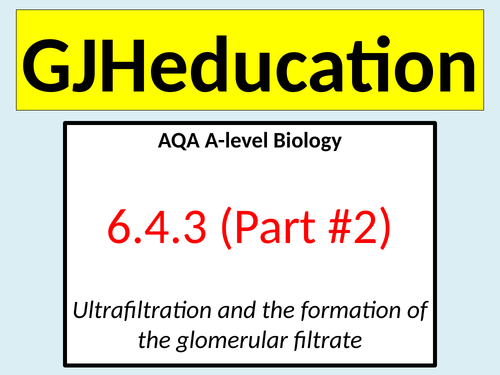




This detailed lesson has been written to cover the part of specification point 6.4.3 of the AQA A-level Biology specification which states that students should be able to describe how the structure of the nephron allows for the formation of glomerular filtrate. The aim of the design was to give the students the opportunity to discover the function of ultrafiltration and to be able to explain how the mechanisms found in the glomerulus and the Bowman’s capsule control the movement of small molecules out of the blood plasma. Key terminology is used throughout and students will learn how the combination of the capillary endothelium and the podocytes creates filtration slits that allow glucose, water, urea and ions through into the Bowman’s capsule but ensure that blood cells and plasma proteins remain in the bloodstream. A number of quiz competitions are used to introduce key terms and values in a fun and memorable way whilst understanding and prior knowledge checks allow the students to assess their understanding of the current topic and to challenge themselves to make links to earlier topics. The final task of the lesson challenges the students to apply their knowledge by recognising substances found in a urine sample that shouldn’t be present and to explain why this would cause a problem
This lesson has been written for students studying on the AQA A-level course and ties in nicely with the other kidney lessons on the structure of the nephron, selective reabsorption and osmoregulation
Get this resource as part of a bundle and save up to 44%
A bundle is a package of resources grouped together to teach a particular topic, or a series of lessons, in one place.
AQA A-level Biology Topic 6: Organisms respond to changes in their internal and external environments
This bundle contains 17 fully-resourced and detailed lessons that have been designed to cover the content of topic 6 of the AQA A-level Biology specification which concerns the responses of organisms to stimuli. The wide range of activities included in each lesson will engage the students whilst the detailed content is covered and the understanding and prior knowledge checks allow them to assess their progress on the current topic as well as challenging them to make links to other related topics. Most of the tasks are differentiated to allow differing abilities to access the work and be challenged. The following sub-topics are covered in this bundle of lessons: * The role of sensory receptors as outlined by the Pacinian corpuscle * The human retina as a sensory receptor * The differences in rods and cones that enable different sensitivity to light, colour and visual acuity * The roles of the SAN, AVN, Bundle of His and Purkyne fibres in the conduction system of the heart * The control of heart rate * The structure of a myelinated motor neurone * The factors that affect the speed of conduction of an impulse * The generation and transmission of nerve impulses * The transmission at a cholinergic synapse and a neuromuscular junction * Summation * The contraction of skeletal muscles * The structure and properties of slow and fast skeletal muscle fibres * The principles of homeostasis including negative feedback systems * The control of blood glucose concentration by the controlled release of insulin and glucagon * The causes and control of diabetes type I and II * The gross structure of the kidney * The detailed structure of the nephron * The production of glomerular filtrate * The reabsorption of glucose and water in the PCT * The role of the hypothalamus, posterior pituitary and ADH in osmoregulation This is one of the 8 topics which have to be covered over the length of the 2 year course and therefore it is expected that the teaching time for this bundle will be in excess of 2 months If you want to see the quality of the lessons before purchasing then the lessons on saltatory conduction, the contraction of skeletal muscles and ultrafiltration are free resources to download
Topic 6.4: Homeostasis is the maintenance of a stable internal environment (AQA A-level Biology)
Each of the 7 lessons that are included in this bundle are fully-resourced and have been designed to cover the content as detailed in topic 6.4 (Homeostasis is the maintenance of a stable internal environment) of the AQA A-Level Biology specification. The specification points that are covered within these lessons include: * The principles of homeostasis * The importance of maintaining temperature and blood glucose concentrations * Negative feedback systems * The action of insulin, glucagon and the role of the liver in blood glucose control * The role of adrenaline * The causes of type I and II diabetes and their control * The structure of the nephron and its numerous roles * The formation of the glomerular filtrate by ultrafiltration * Reabsorption of glucose and water by the proximal convoluted tubule * The roles of the hypothalamus, the posterior pituitary gland and ADH in osmoregulation The lessons have been written to include a wide range of activities and numerous understanding and prior knowledge checks so students can assess their progress against the current topic as well as be challenged to make links to other topics within this topic and earlier topics If you would like to see the quality of the lessons, download the ultrafiltration lesson which is free
Something went wrong, please try again later.
Not the best resource for A-LEVEL. Useful facts to cherrypick as a starter but no good as a lesson on its own. No structure or function and not really challenging enough application questioning to check understanding . Disappointed and glad it was free.
Lovely resource, again thanks for sharing.
Report this resourceto let us know if it violates our terms and conditions.
Our customer service team will review your report and will be in touch.